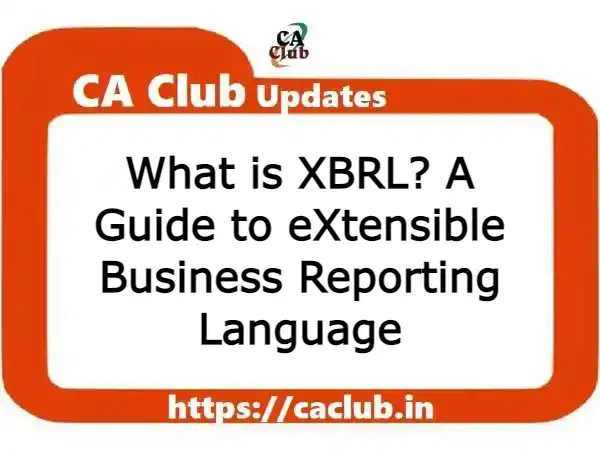XBRL or eXtensible Business Reporting Language is a language for the electronic communication of business and financial data which is revolutionizing business reporting around the world. In this article, we’ll explore what XBRL is, its advantages, who developed it, and its future. We’ll also discuss how companies can create statements in XBRL, who can benefit from using it, and more.
What is XBRL?
XBRL is a language for the electronic communication of business and financial data which is revolutionizing business reporting around the world. It provides major benefits in the preparation, analysis, and communication of business information. It offers cost savings, greater efficiency, and improved accuracy and reliability to all those involved in supplying or using financial data.
XBRL is an extensible language that is intended to support all current aspects of reporting in different countries and industries. Its extensible nature means that it can be adjusted to meet particular business requirements, even at the individual organization level.
Who Developed XBRL?
XBRL is an open, royalty-free software specification developed through a process of collaboration between accountants and technologists from all over the world. Together, they formed XBRL International, which is now made up of over 650 members, including global companies, accounting, technology, government, and financial services bodies.
What are the Advantages of XBRL?
XBRL offers major benefits at all stages of business reporting and analysis. The benefits are seen in automation, cost savings, faster, more reliable, and more accurate handling of data, improved analysis, and in better quality of information and decision-making.
XBRL enables producers and consumers of financial data to switch resources away from costly manual processes, typically involving time-consuming comparison, assembly, and re-entry of data. They are able to concentrate effort on analysis, aided by software which can validate and process XBRL information.
Who Can Benefit from Using XBRL?
All types of organizations can use XBRL to save costs and improve efficiency in handling business and financial information. Because XBRL is extensible and flexible, it can be adapted to a wide variety of different requirements. All participants in the financial information supply chain can benefit, whether they are preparers, transmitters or users of business data.
What is the Future of XBRL?
XBRL is set to become the standard way of recording, storing, and transmitting business financial information. It is capable of use throughout the world, whatever the language of the country concerned, for a wide variety of business purposes. It will deliver major cost savings and gains in efficiency, improving processes in companies, governments, and other organizations.
How Does XBRL Work?
XBRL makes the data readable, with the help of two documents – Taxonomy and instance document. Taxonomy defines the elements and their relationships based on the regulatory requirements. Using the taxonomy prescribed by the regulators, companies need to map their reports and generate a valid XBRL instance document.
How Do Companies Create Statements in XBRL?
There are a number of ways to create financial statements in XBRL:
- XBRL-aware accounting software products are becoming available which will support the export of data in XBRL form. These tools allow users to map charts of accounts and other structures to XBRL tags.
- Statements can be mapped into XBRL using XBRL software tools designed for this purpose.
- Data from accounting databases can be extracted in XBRL format. It is not strictly necessary for an accounting software vendor to use XBRL; third party products can achieve the transformation of the data to XBRL.
- Applications can transform data in particular formats into XBRL.
Does XBRL Benefit the Comparability of Financial Statements?
XBRL benefits comparability by helping to identify data which is genuinely alike and distinguishing information which is not comparable. Computers can process this information and populate both predefined and customized reports, leading to more accurate and reliable analysis and decision-making.
Benefits to Companies
By presenting financial statements in XBRL, a company can benefit investors and other stakeholders and enhance its profile. It will also meet the requirements of regulators, lenders, and other consumers of financial information, who are increasingly demanding reporting in XBRL. This will improve business relations and lead to a range of benefits.
With full adoption of XBRL, companies can automate data collection. For example, data from different company divisions with different accounting systems can be assembled quickly, cheaply, and efficiently. Once data is gathered in XBRL, different types of reports using varying subsets of the data can be produced with minimum effort. A company finance division, for example, could quickly and reliably generate internal management reports, financial statements for publication, tax and other regulatory filings, as well as credit reports for lenders. Not only can data handling be automated, removing time-consuming, error-prone processes, but the data can be checked by software for accuracy.
XBRL Taxonomy
Taxonomy can be referred to as an electronic dictionary of the reporting concepts. It consists of all the data definitions, the basic XBRL properties, and the interrelationships amongst the concepts. Taxonomies may represent hundreds or even thousands of individual business reporting concepts, mathematical and definitional relationships among them, along with text labels in multiple languages, references to authoritative literature, and information about how to display each concept to a user. Taxonomies are based on regulatory requirements and standards that are to be followed by the companies.
Conclusion
In conclusion, XBRL is revolutionizing business reporting and offers major benefits at all stages of business reporting and analysis. It enables producers and consumers of financial data to switch resources away from costly manual processes and concentrate effort on analysis, aided by software that can validate and process XBRL information. All types of organizations can use XBRL to save costs and improve efficiency in handling business and financial information. Companies can benefit from XBRL by enhancing their profile, meeting regulatory requirements, and automating data collection, leading to more accurate and reliable analysis and decision-making. Taxonomies for Indian companies are available at http://www.xbrl.org/in.
